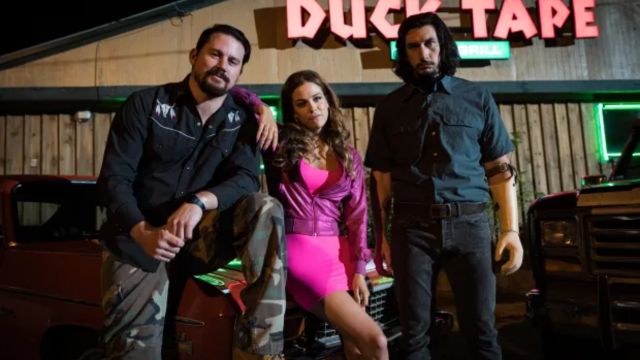Is Lucky Logan Based on a True Story? The Inspiration Behind the Film
The 2017 heist movie “Logan Lucky,” directed by Steven Soderbergh, effectively tells the tale of a theft at NASCAR and is full of individuals whose Southern heritage inspires a certain type of easy humor.
The story centers on Jimmy, Clyde, and Millie Logan, three siblings who have seen a lengthy run of misfortune. As a result, the siblings resolve to steal from the Charlotte Motor Speedway in North Carolina in an attempt to demonstrate that their family curse is a fiction.
The Logans set out to steal from the Speedway while the tracks supervise the largest event of the year, NASCAR’s Coca-Cola 600 race, after enlisting Joe Bang, a safe cracker imprisoned for his previous pranks.
The film creates the most cohesive story about a chaotic theft by balancing its lofty plotlines against its grounded people. As a result, one is compelled to get interested in the Logans and their possible real-life foundation given its largely plausible plot.
Logan Lucky Uses Reality As Motivation
The beginnings of “Logan Lucky” are intriguing, but not for the reasons one might anticipate. Under Steven Soderbergh’s direction, the movie’s portrayal of a NASCAR robbery maintains a high degree of authenticity, but the plot itself is unrelated to the same actual occurrences.
Rather, the story is still largely fictional, and Rebecca Blunt wrote the screenplay. According to accounts, the screenwriter got the concept from a sinkhole that appeared in the Charlotte Motor Speedway’s infield in 2010.
Officials at the time determined that the sinkhole’s placement over a dump and the recent, intense rainfall were the likely causes.
That being said, the problem was resolved quickly and there was no underground heist. Nevertheless, the sinkhole’s heist-less reality was sufficient to motivate Blunt to devise a motley crew of bandits, a single, intricate yet exciting network of pneumatic bank tubes, and a robbery to execute against the backdrop of NASCAR.
As a result, the use of the Charlotte Motor Speedway sinkhole as a key plot device gives the movie a tenuous link to truth. However, except from that, none of the individuals or their stories are relevant to reality. The movie is still primarily fictional for the same reason.
The Secret Identity of Rebecca Blunt
Because there aren’t many actual heists at the NASCAR, “Logan Lucky” solidifies as a work of fiction. Yet, screenwriter Rebecca Blunt reveals yet another fascinating facet of the movie’s beginnings.
The author, who was thought to be adopting a pseudonym to conceal their true identity, was the subject of a significant mystery at the time of the movie’s premiere and for a few years after.
Blunt seldom appeared during the press tour, and only a select few project participants, such as Soderbergh or actor Adam Driver, were able to discuss the writer’s existence with assurance. For a while, Soderbergh and others defended Blunt’s status as a legitimate screenwriter in the face of rumors, but eventually the truth was revealed.
It turns out that Blunt is actually Jules Asner’s pen name, and “Logan Lucky” is his first screenplay. Asner, who is married to Soderbergh, chose to conceal her identity in connection with the movie. She allegedly made this choice because she didn’t want the world to know that her spouse was directing a movie she had written.
Given Asner’s relationship to the filmmaker, the author might have been concerned that viewers would already have preconceived notions about the movie. She ultimately decided to use a pseudonym in order to focus all attention on the movie for the same purpose.
Logan Lucky Attracted Soderbergh with His Anti-Glamourous Heist
Logan Lucky does a fantastic job at simulating a genuine story, even though it is a work of fiction. This is partially due to the realistic study that was done for the movie’s portrayal of racetracks and pneumatic bank tubes. However, the plot’s grounded characters are also quite important.
Interestingly, this drew Steven Soderbergh to the project and forced him to come out of retirement. Speaking to Entertainment Weekly, Soderbergh revealed, “On the most obvious level, it’s the complete inversion of a ‘Ocean’s’ movie.”
It’s a less glamorous take on a “Ocean’s” film. No one wears great clothes. No one has nice things. They’re broke. They don’t have any technologies.
“It’s all rubber band technology, and that’s what I found entertaining about it,” he continued. By ensuring a genuine backdrop for its plot, the film further extends its sense of realism beyond its characters and their narratives.
It seemed familiar to me, yet sufficiently different. Soderbergh and his team understood they wanted to get the genuine thing for their on-screen version because the film takes place during a NASCAR event.
“We worked very hard to get NASCAR on board as a partner because we really felt that it was critical because if you couldn’t shoot at the real race and put your people there, then it just wouldn’t be compelling,” he said in a discussion about the same. As a result, even though the main heist in “Logan Lucky” has fictional origins, the story maintains a notable sense of realism.
See the thrilling Logan Lucky heist, as comedy and high-stakes action collide at NASCAR’s premier event! Explore Soderbergh’s vision, the film’s covert screenwriter, and its real-life influences. Do you want to learn more about your favorite films? For the most recent in-depth analyses of the greatest mysteries in film, visit our website!




Comments are closed.